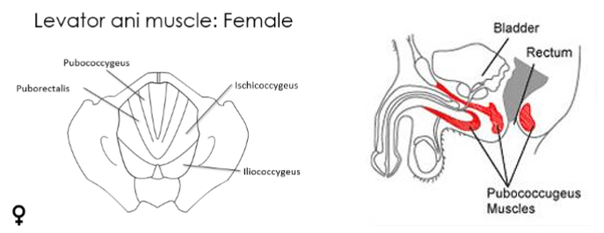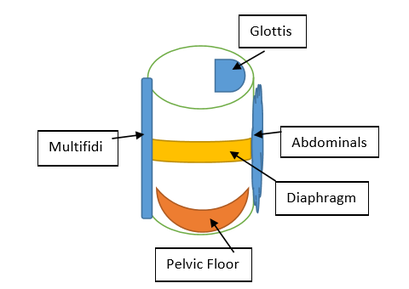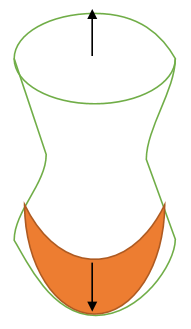Why You Pee When You Do Double Unders
Mar 24, 2016Midline stabilization is heralded as the foundation of safe and successful weightlifting. But have we been ignoring a part of the “core”? The pelvic floor is a topic that tends to be avoided. Most people do not casually discuss urinary frequency over coffee or admit to their coach that they pee every time they perform double-unders. Men- if you think this one is just for the women, stick around!
I only realized the prevalence of leakage after CrossFit HQ posted a video following regionals. All of these women were saying “It’s ok, I pee during workouts too. It’s normal!” Please do not confuse normal and common. Urinary incontinence may be common in certain populations, especially of heavy lifters, but it is absolutely not normal.
The pelvic floor includes a group of muscles that attach from your coccyx (tail bone) and sacrum to your pelvic ring.

These muscles are important for bowel and bladder function, organ support, and stability of the pelvis. Although pelvic floor dysfunction (PFD) was thought to be largely a problem of women, it is becoming apparent that men have similar issues. The pelvic floor may seem very foreign and uncomfortable to discuss, but when it properly functions it can improve your workouts. Here’s how:
I like Mary Massery’s description of the core as a “soda-pop can”. The front of the can is the abs, the back is the multifidi, the pop top is the glottis and the bottom of the can is the pelvic floor. The core pressure is maintained by a functioning glottis and pelvic floor, with the diaphragm acting as a pressure regulator.

When you take a breath in, the diaphragm descends. This requires the pelvic floor muscles to descend and lengthen. When you exhale the diaphragm rises and the pelvic floor rises and tightens.
In fit individuals, (notice I said individuals and not just women), a common pelvic floor problem is overactive muscles. Very strong back or abdominal muscles can cause increased inward pressure. It’s been shown that when your deep abdominals contract, so does your pelvic floor.
Imagine squeezing the can from both sides with the pressure maintained. The bottom and top will have to withstand more pressure and bulge. If your abdominals are always squeezing in then your pelvic floor is always pushing up to withstand the pressure. It’s overworked! The diaphragm is pretty darn good at its job. If it does not work, we have a bigger issue on our hands.
So often, when something’s ‘gotta give’- it’s the pelvic floor. When all of these muscles work in concert, your canister and the force it can produce is maximized. Thus, your workout improves.
A conversation about breathing techniques regarding the glottis and diaphragm is essential to training the entire core. Here I am simply touching on one contribution but remember it does not work alone.
Keep in mind, PFD can also manifest in ways such as pelvic pain, painful intercourse, low back pain, urinary frequency or even the dreaded butt wink. It is not just urinary incontinence.
“ Pelvic floor pain is only caused by pregnancy, right?”

Wrong. There has been no correlation shown between PFD and post-partum women. Sure, some moms experience issues but again, it is not normal for any population. Weakness and/or tightness of the pelvic floor can be caused by poor postural habits, extended periods of sitting, over training of the abdominals and pregnancy. Excluding pregnancy of course, men are susceptible to all of the other risk factors.
“Ok, so I pee on myself at the gym and it’s not normal. What do I do to stop it?”
- Minimize extended periods of sitting. Standing is definitely superior to sitting but if you can, squat. Hanging out in the bottom of your squat while you type an email can effectively lengthen the pelvic floor muscles.
- Check your posture. Slumped sitting will lead to a laundry list of issues from head to toe, inside and out. But specifically, avoid slumped or “sacral sitting” with your pelvis tucked under and your lumbar curve reversed. This causes the pelvic floor muscles to maintain an abnormal length for extended periods.
- Train naked. Ok, not no-clothes naked but no-gear naked. Take off the wrist wraps, knee sleeves, weight belt, K-tape, etc. Make training about you and your barbell. Minimizing the amount of external support will expose your weak areas and teach your body to naturally stabilize. So you can’t PR your clean without your gear? Keep training at that safe, lower weight where your body can appropriately respond and adapt. You’ll thank me later.
- If you have continual issues or have specific questions, contact your local pelvic floor physical therapist. They can help identify dysfunction and provide specific, individualized treatments.
Thanks for reading!
Dr. Jackie, PT, DPT, CSCS
References:
Sapsford, Ruth R, Hodges, Paul W. Contraction of the Pelvic Floor Muscles during Abdominal Maneuvers. Physical Medicine and Rehabilitation, 2001, Vol.82(8), pp.1081-1088.
Healthyplace.com
Presentation at CSM 2016 by Mary Massery: referencing Massery 2005 & 2006.
Let us help you figure out to live your best active life today!
Remember, Movement is Medicine!

